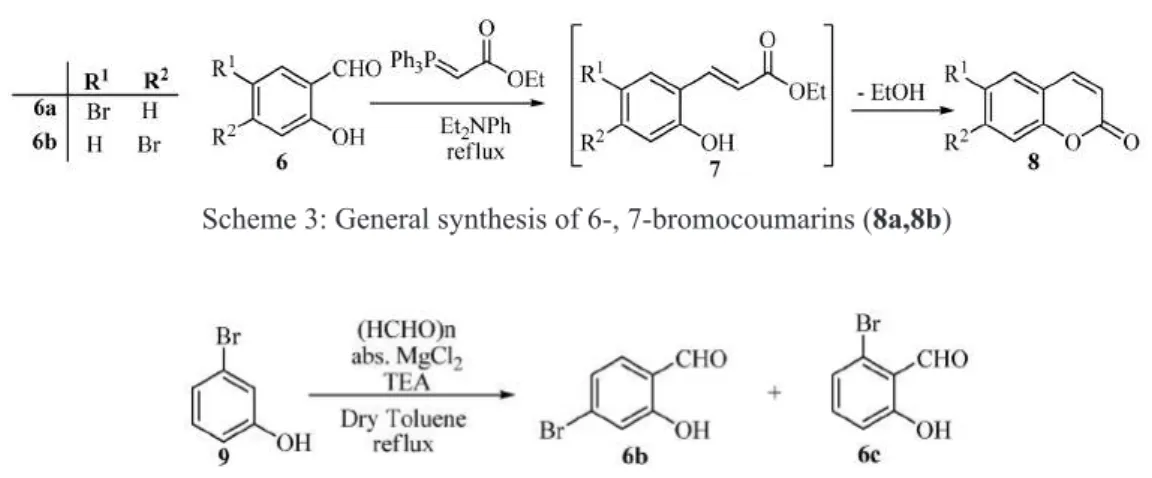SYNTHESIS AND ULLMANN TYPE AMINATION REACTIONS OF BROMOCOUMARINS
Zoltán Sipos1, Tamás Patonay1
1Department of Organic Chemistry, University of Debrecen H-4032, Debrecen, Egyetem tér 1.
ABSTRACT
3-, 4-, 6- and 7-bromocoumarin were prepared by two different methods. 3-bromocoumarin was synthesized by bromination of coumarin and 4-bromocoumarin was prepared on the same way starting from 4-hydroxycoumarin.
6- and 7-bromocoumarin were prepared by Wittig reaction of bromosalicylaldehydes and the proper Wittig reagent. Ullmann coupling reactions were carried out from the synthesized bromocoumarin derivatives using aliphatic and aromatic amines under different conditions to obtain the corresponding aminocoumarins with different copper catalyst.
1 INTRODUCTION
Although the two most commonly used metals in metal catalyzed cross coupling syntheses are palladium and nickel, copper also has a quite long history, as F. Ullmann successfully used copper in the synthesis of biphenyl derivatives as early as 1901 (Ullmann, 1901). The copper catalyzed, so called Ullmann type reactions most recently became popular again since new methods using ligands, bases and different sources of copper (Evano, 2008) allow to apply much lower temperature that is more tolerable for different functional groups. Copper could be preferred over palladium as it is cheaper and easier to handle further copper catalysts are not sensible to moisture.
In our research group extensive research is being carried out with oxygen containing heterocycles such as coumarins. The palladium catalyzed Buchwald-Hartwig amination of coumarins was examined quite thoroughly in the research group. As a continuation of this study our goal was to examine the copper catalyzed amination of different bromocoumarins.
2 RESULTS AND DISCUSSION
The syntheses of different bromocoumarins were carried out according to Scheme 1-3. In case of 3-bromocoumarin (2) using method A the reaction took place under three days and yielded the mono- and dibromo derivatives (2,3). 4-Bromocoumarin was synthesized from 4-hydroxycoumarin with moderate yield.
Scheme 1: Methods for the preparation of 3-bromocoumarin (2)
Scheme 2: Synthesis of 4-bromocoumarin (5)
The 6- and 7-bromocoumarin (8a, 8c) were synthesized from the appropriate bromosalicylaldehydes (6a, 6c) by Wittig reaction (Harayama, 1994). 4-Bromo-salicylaldehyde (6a) was prepared from 3-bromophenol (9) with formaldehyde (Scheme 4).
59
1stInnovation in Science 2014 – Doctoral Student Conference – Szeged, Hungary Chemistry section – Oral lectures
Scheme 3: General synthesis of 6-, 7-bromocoumarins (8a,8b)
Scheme 4: Synthesis of 4-bromosalicylaldehyde (6b); the reaction also results the 6-bromosalicylaldehyde (6c)
During the synthesis of 6-bromocoumarin (8a) the expected product was isolated with low yield, the main product of the reaction was the corresponding intermediate7a. Pre-experiments were carried out for the ringclosure of7 with the help of microwave (Table 1).
Table 1: Microwave heated ringclosure reactions; conversions estimated upon TLC
The Ullmann type coupling reactions were attempted using different aliphatic and aromatic amines, Cu(OAc)2or CuCN as catalyst, various ligands and NaOtBu or K3PO4as base (Scheme 5). In case of 3-bromocoumarin (2) the isolation of 3-aminocoumarin derivatives (10a) occurred in low to medium yields.
Scheme 5: General syntheses of the aminocoumarins (10a-d)
During the coupling of 4-bromocoumarin (5) with different aliphatic amines the 3-substituted coumarin derivatives (10a) were also isolated occasionally with low yields due to a rearrangement process.
3 REFERENCES
Ewano, G.; Blachard, N.; Toumi, M. (2008),Chem. Rev.108, 3054-3131.
Harayama, T.; Nakatsuka, K.; Nishioka, H.; Murakami, K.; Hayashida, N.; Ishii, H. (1994)Chem. Pharm. Bull.42, 2170-2173.
Ullmann, F.; Bieleczki, J. (1901), Ber. Dtsch. Chem. Ges.34, 2174.
This research was supported by theEuropean Unionand theState of Hungary, co-financed by the European Social Fundin the framework of TÁMOP-4.2.4.A/ 2-11/1-2012-0001 ‘National Excellence Program’.
60
1stInnovation in Science 2014 – Doctoral Student Conference – Szeged, Hungary Chemistry section – Oral lectures
